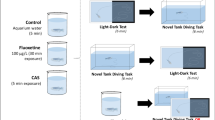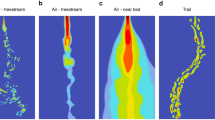Abstract
The biogenic amine, octopamine, modulates a variety of aspects of insect motor behavior, including direct action on the flight central pattern generator. A number of recent studies demonstrate that tyramine, the biological precursor of octopamine, also affects invertebrate locomotor behaviors, including insect flight. However, it is not clear whether the central pattern generating networks are directly affected by both amines, octopamine and tyramine. In this study, we tested whether tyramine affected the central pattern generator for flight in the moth, Manduca sexta. Fictive flight was induced in an isolated ventral nerve cord preparation by bath application of the octopamine agonist, chlordimeform, to test potential effects of tyramine on the flight central pattern generator by pharmacological manipulations. The results demonstrate that octopamine but not tyramine is sufficient to induce fictive flight in the isolated ventral nerve cord. During chlordimeform induced fictive flight, bath application of tyramine selectively increases synaptic drive to depressor motoneurons, increases the number of depressor spikes during each cycle and decreases the depressor phase. Conversely, blocking tyramine receptors selectively reduces depressor motoneuron activity, but does not affect cycle by cycle elevator motoneuron spiking. Therefore, octopamine and tyramine exert distinct effects on the flight central pattern generating network.






Similar content being viewed by others
Abbreviations
- CDM:
-
Chlordimeform
- MN1-5:
-
Motoneurons 1-5
References
Alkema MJ, Hunter-Ensor M, Ringstad N, Horvitz HR (2005) Tyramine functions independently of octopamine in the Caenorhabditis elegans nervous system. Neuron 46:247–260
Baier A, Wittek B, Brembs B (2002) Drosophila as a model organism for the neurobiology of aggression. J Exp Biol 205:1233–1240
Blenau W, Baumann A (2001) Molecular and pharmacological properties of insect biogenic amine receptors: lessons from Drosophila melanogaster and Apis mellifera. Arch Insect Biochem Physiol 48(1):13–38
Blenau W, Baumann A (2003) Aminergic signal transduction in invertebrates: focus on tyramine and octopamine receptors. Recent Res Dev Neurochem 6:225–240
Bozic J, Woodring J (1998) Variations of brain biogenic amines in mature honeybees and induction of recruitment behavior. Comp Biochem Physiol A 120:737–744
Brembs B, Christiansen F, Pflueger HJ, Duch C (2007) Flight initiation and maintenance deficits in flies with genetically altered biogenic amine levels. J Neurosci 27(41):11122–11131
Buhl E, Schildberger K, Stevenson PA (2008) A muscarinic cholinergic mechanism underlies activation of the central pattern generator for locust flight. J Exp Biol 211:2346–2357
Cazzamali G, Klaerke DA, Grimmelikhuijzen CJP (2005) A new family of insect tyramine receptors. Biochem Biophys Res Commun 2:1189–1196
Chatwin HM, Rudling JE, Patel D, Reale V, Evans PD (2003) Site-directed mutagenesis studies on the Drosophila octopamine/tyramine receptor. Insect Biochem Mol Biol 33(2):173–184
Claassen DE, Kammer AE (1986) Effects of octopamine, dopamine, and serotonin on production of flight motor output by thoracic ganglia of Manduca sexta. J Neurobiol 17:1–14
Degen J, Gewecke M, Roeder T (2000) Octopamine receptors in the honey bee and locust nervous system: pharmacological similarities between homologous receptors of distantly related species. Br J Pharmacol 130:587–594
Duch C, Pflueger HJ (1999) DUM neurons in locust flight: a model system for amine-mediated peripheral adjustments to the requirements of a central motor program. J Comp Physiol A 184:489–499
Eaton JL (1988) Lepidopteran anatomy, Wiley, New York
Edwards JS (2006) The central nervous control of insect flight. J Exp Biol 209:4411–4413
Evans PD, Maqueira B (2005) Insect octopamine receptors: a new classification scheme based on studies of cloned Drosophila G-protein coupled receptors. Invert Neurosci 5(3–4):111–118
Evans PD, O’Shea M (1979) An octopaminergic neuron modulates neuromuscular transmission in the locust. Nature 270:257–259
Fox LE, Soll DR, Wu CF (2006) Coordination and modulation of locomotion pattern generators in Drosophila larvae: effects of altered biogenic amine levels by the tyramine β hydroxylase mutation. J Neurosci 26:1486–1498
Grillner S, Markram H, De Schutter E, Silberberg G, LeBeau FE (2005) Microcircuits in action—from CPGs to neocortex. Trends Neurosci 28:525–533
Harris JW, Woodring J (1992) Effects of stress, age, season, and source colony on levels of octopamine, dopamine and serotonin in the honey bee (Apis mellifera L) brain. J Insect Physiol 38:29–35
Hoyle G (1985) Generation of motor activity and control of behavior: the role of the neuromodulator octopamine and the orchestration hypothesis. In: Kerkut GA, Gilbert L (eds) Comp insect physiol, biochem pharmacol 5. Pergamon, Toronto, pp 607–621
Johnston RM, Levine RB (2002) Thoracic leg motoneurons in the isolated CNS of adult Manduca produce patterned activity in response to pilocarpine, which is distinct from that produced in larvae. Invert Neurosci 4(4):175–192
Kammer AE (1967) Muscle activity during flight in some large lepidoptera. J Exp Biol 47:277–295
Kiehn O, Kullander K (2004) Central pattern generators deciphered by molecular genetics. Neuron 41:317–321
Kinnamon SC, Klaassen LW, Kammer AE, Claassen D (1984) Octopamine and chlordimeform enhance sensory responsiveness and production of the flight motor pattern in developing and adult moths. J Neurobiol 15:283–293
Kobayashi EA (2001) Role of catecholamine signaling in brain and nervous system functions: new insights from mouse molecular genetic study. J Investig Dermatol Symp Proc 6:115–121
Kononenko NL, Wolfenberg H, Pflüger H-J (2008) Tyramine as an independent transmitter and a precursor of octopamine in the locust central nervous system: an immunocytochemical study. J Comp Neurol 512(4):433–542
Kravitz EA, Huber R (2003) Aggression in invertebrates. Curr Opin Neurobiol 13:736–743
Lange AB (2008) Tyramine: from octopamine precursor to neuroactive chemicals in insects. Gen Comp Endocrinol (Epub ahead of print)
Leitch B, Judge S, Pitman RM (2003) Octopaminergic modulation of synaptic transmission between an identified sensory afferent and flight motoneuron in the locust. J Comp Neurol 462:55–70
Marder E, Bucher D (2001) Central pattern generators and the control of rhythmic movements. Curr Biol 11:R986–R996
Marder E, Calabrese RL (1996) Principles of rhythmic motor pattern generation. Physiol Rev 76:687–717
Marder E, Bucher D, Schulz DJ, Taylor AL (2005) Invertebrate central pattern generation moves along. Curr Biol 6:R685–R699
Matheson T (1997) Octopamine modulates the responses and presynaptic inhibition of proprioceptive sensory neurones in the locust Schistocerca gregaria. J Exp Biol 200:1317–1325
McClung C, Hirsh J (1999) The trace amine tyramine is essential for sensitization to cocaine in Drosophila. Curr Biol 9:853–860
Mentel T, Duch C, Stypa H, Wegener G, Mueller U, Pflueger HJ (2003) Central modulatory neurons control fuel selection in flight muscle of migratory locust. J Neurosci 23:1109–1113
Monastirioti M, Gorczyca M, Rapus J, Ecker M, White K, Budnik V (1995) Octopamine immunoreactivity in the fruitfly Drosophila melanogaster. J Comp Neurol 356:275–287
Mustard JA, Kurshan PT, Hamilton IS, Blenau W, Mercer AR (2005) Developmental expression of a tyramine receptor gene in the brain of the honey bee, Apis mellifera. J Comp Neurol 483:66–75
Nagaya Y, Kutsukake M, Chigusa SI, Komatsu A (2002) A trace amine, tyramine, functions as a neuromodulator in Drosophila melanogaster. Neurosci Lett 329:324–328
Nusbaum MP, Blitz DM, Swensen AM, Wood D, Marder E (2001) The roles of co-transmission in neural network modulation. Trends Neurosci 24:146–154
Ohta H, Utsumi T, Ozoe Y (2003) B96Bom encodes a Bombyx mori tyramine receptor negatively coupled to adenylate cyclase. Insect Mol Biol 12:217–223
Orchard I, Ramirez JM, Lange AB (1993) A multifunctional role for octopamine in locust flight. Annu Rev Entomol 38:227–249
Pearson KG (2004) Generating the walking gait: role of sensory feedback. Prog Brain Res 143:123–129
Pflüger H-J (1999) Neuromodulation during motor development and behavior. Curr Opin Neurobiol 9:683–689
Pflüger H-J, Watson AHD (1995) GABA- and glutamate-like immunoreactivity in central synapses of dorsal unpaired median neurones in the abdominal nerve cord of locusts. Cell Tissue Res 280:325–333
Pflüger H-J, Witten JL, Levine RB (1993) Fate of abdominal ventral unpaired median cells during metamorphosis of the hawkmoth, Manduca sexta. J Comp Neurol 335:508–522
Popova NK (2006) From genes to aggressive behavior: the role of the serotonergic system. BioEssays 28:495–503
Ramirez JM, Pearson KG (1991a) Octopaminergic modulation of interneurons in the flight system of the locust. J Neurophysiol 66(5):1522–1537
Ramirez JM, Pearson KG (1991b) Octopaminergic modulation of plateau potentials in the flight system of the locust. Brain Res 549:332–337
Riemensperger T, Voller T, Stock P, Buchner E, Fiala A (2005) Punishment prediction by dopaminergic neurons in Drosophila. Curr Biol 16:1741–1747
Roeder T (1999) Octopamine in invertebrates. Prog Neurobiol 59:533–561
Roeder T, Degen J, Gewecke M (1998) Epinastine, a highly specific antagonist of insect neuronal octopamine receptors. Eur J Pharmacol 349:171–177
Saraswati S, Fox LE, Soll DR, Wu CF (2004) Tyramine and octopamine have opposite effects on the locomotion of Drosophila larvae. J Neurobiol 58:425–441
Saudou F, Amlaiky N, Plassat JL, Borrelli E, Hen R (1990) Cloning and characterization of a Drosophila tyramine receptor. EMBO J 9:3611–3617
Scholtissen B, Verhey FR, Steinbusch HW, Leentjens AF (2006) Serotonergic mechanisms in Parkinson’s disease: opposing results from preclinical and clinical data. J Neural Transm 113:59–73
Schulz DJ, Robinson GE (2001) Octopamine influences division of labor in honey bee colonies. J Comp Physiol A 187:53–61
Schwaerzel M, Monastirioti M, Scholz H, Friggi-Grelin F, Birman S, Heisenberg M (2003) Dopamine and octopamine differentiate between aversive and appetitive olfactory memories in Drosophila. J Neurosci 23:10495–10502
Sombati S, Hoyle G (1984) Generation of specific behaviors in a locust by local release into neuropil of the natural neuromodulator octopamine. J Neurobiol 15:481–506
Stevenson PA, Kutsch W (1987) A reconsideration of the central pattern generator concept for locust flight. J Comp Physiol A 161:115–129
Stevenson PA, Dyakonova V, Rillich J, Schildberger K (2005) Octopamine and experience-dependent modulation of aggression in crickets. J Neurosci 25:1431–1441
Taylor C, Fricker AD, Devi LA, Gomes I (2005) Mechanisms of action of antidepressants: from neurotransmitter systems to signaling pathways. Cell Signal 17:549–557
Trimmer BA, Weeks JC (1989) Effects of nicotinic and muscarinic agents on an identified motoneuron and its direct afferent inputs in larval Manduca sexta. J Exp Biol 144:303–337
Tu MS, Daniel TL (2004) Submaximal power output from the dorsolongitudinal flight muscles of the hawkmoth, Manduca sexta. J Exp Biol 207:4651–4662
Vanden Broeck J, Vulsteke V, Huybrechts R, De Loof A (1995) Characterization of a cloned locust tyramine receptor cDNA by functional expression in permanently transformed Drosophila S2 cells. J Neurochem 64:2387–2395
Wagener-Hulme C, Kuehn JC, Schulz DJ, Robinson GE (1999) Biogenic amines and division of labor in honey bee colonies. J Comp Physiol A 184:471–479
Wilson DM (1961) The central nervous control of locust flight. J Exp Biol 38:471–490
Wilson DM (1966) Central nervous mechanisms for the generation of rhythmic behavior in arthropods. Symp Soc Exp Biol 20:199–228
Wilson DM, Wyman RJ (1965) Motor output patterns during random and rhythmic stimulation of locust thoracic ganglia. Biophys J 5:121–143
Acknowledgments
R. Vierk was supported by DFG Graduate College, GRK 837 (Functional Insect Science). The experiments comply with the “Principles of animal care”, publication No. 86-23, revised 1985 of the National Institute of Health, and also with the current laws of Germany where the experiments were performed.
Author information
Authors and Affiliations
Corresponding author
Rights and permissions
About this article
Cite this article
Vierk, R., Pflueger, H.J. & Duch, C. Differential effects of octopamine and tyramine on the central pattern generator for Manduca flight. J Comp Physiol A 195, 265–277 (2009). https://doi.org/10.1007/s00359-008-0404-5
Received:
Revised:
Accepted:
Published:
Issue Date:
DOI: https://doi.org/10.1007/s00359-008-0404-5




